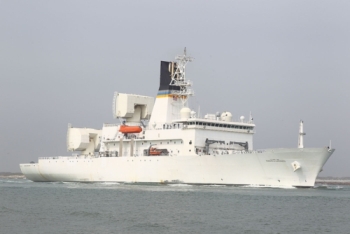The Raytheon Company - led Cobra Judy Replacement (CJR) program surpassed expectations during its first tests against a live rocket launch on March 19. From approximately 100 miles off the Florida coast, the powerful X- and S-band radars integrated onboard the USNS Howard O. Lorenzen (T-AGM 25) successfully acquired and tracked both stages of an Atlas V rocket launched from Cape Canaveral and collected all associated data.
 Cobra Judy Replacement: The exceptional demonstration of CJR's performance during its first live-launch test validates its mission capability, advancing the program on schedule toward Initial Operational Capability in January 2014. Photo Credit: Raytheon.
Cobra Judy Replacement: The exceptional demonstration of CJR's performance during its first live-launch test validates its mission capability, advancing the program on schedule toward Initial Operational Capability in January 2014. Photo Credit: Raytheon.
The exceptional demonstration of CJR's performance validates its mission capability, advancing the program on schedule toward Initial Operational Capability (IOC) in January 2014. To be deployed as a strategic, global asset for ballistic missile monitoring, data collection and treaty verification, the large-scale, complex dual-band radar suite of CJR consists of X- and S-band phased-array sensors, a common radar suite controller and other related mission equipment.
"CJR continues to excel at each stage of development and testing – no small feat for a new program with its level of scale and complexity," said U.S. Navy Captain Rod Wester , CJR program manager, Program Executive Office – Integrated Warfare Systems (PEO IWS 2I). "The performance of the radars – and the platform as a whole – has been outstanding and it is a testament to the skill, experience and dedication of the government-industry team of experts, working together to bring this critical capability closer to deployment."
Raytheon is the prime contractor for the CJR mission equipment and principal on an industry team that includes Northrop Grumman Electronic Systems. The team has been a model of collaboration, focused on the delivery of a high-performing shipboard radar capability that the U.S. Navy, the U.S. Air Force and the nation can rely upon as a critical global asset.
This live-launch exercise follows a series of achievements for this true dual-band, active phased-array radar suite. Since at-sea testing began in July 2012, the program team has been incrementally testing and fine-tuning the radars against targets of increasing complexity. In late 2012, two critical firsts were achieved: the demonstration of full-power radiation capability of the high-sensitivity shipboard X- and S-band radars; and the successful dual-band acquisition and tracking of satellites under the control of the CJR common radar suite controller.
About CJR
Integrated onboard this complex, mission-critical platform, the massive X- and S-band active phased-array antennas of CJR are each approximately four stories tall and weigh more than 500,000 pounds. Raytheon completed the shipboard installation of CJR mission equipment at Kiewit Offshore Services, Corpus Christi, Texas, in October 2011, ahead of plan. The mission of the CJR program is to provide the government with long-loiter ballistic missile data collection capability in support of international treaty verification. CJR replaces the original Cobra Judy, USNS Observation Island, also developed by Raytheon and in service since 1981. CJR is planned to enter service in January 2014; the U.S. Navy will take delivery of CJR and transfer to the U.S. Air Force for operational ownership.
Raytheon's Radar Expertise
Raytheon's skill and experience working with large-scale, active phased-array radars spans the frequency spectrum and dates back to the original Cobra Judy and Early Warning Radar programs -- continuing today with the advanced Dual Band Radar, AN/TPY-2 and Cobra Judy Replacement programs.
The company has a long heritage of developing and producing some of the world's most capable air and missile defense radars, dating back to the 1940s. Raytheon has produced more than 1.8 million AESA (active electronically scanned array) T/R modules to date and has decades of experience working with adaptive beamforming technologies. Raytheon is also the industry leader in high-performance GaN technology.